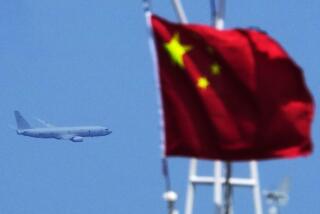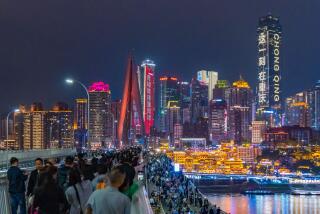It’s a Juggernaut ... Not!
- Share via
Beginning with Marco Polo’s sojourn in China in the late 13th century, there have been two Chinas — the China of the imagination, as interpreted by Westerners, and the real China as experienced by the Chinese. Post-imperial China provided some of the most powerful images of the 20th century. As we still see in old newsreels and magazines, Shanghai in the 1930s was a center of international glamour and intrigue. Next came the utter destruction of World War II, then Mao’s China and the rampages of the Red Guard.
Today, China’s economic rise, symbolized by space-needle towers and construction cranes in major cities, occupy a similar romanticized place in the minds of foreign commentators. As I write this article while flying over China, I am reminded of what lies beneath. China has its own vast and enduring reality, its own strengths and its own weaknesses. When outsiders speak of China, when you see media images of China, you should remind yourself that most of what we Westerners see and discuss are simply journalistic myths. The problem with these myths is that they interfere with our ability to understand what is really going on in China, and what is really going on is hugely important to everyone on the planet.
Chinese history is barely studied in the United States. I find that many people who talk about China sprinkle a few facts on a well-worn agenda. I often hear comments that the Chinese are taking our jobs and stealing our intellectual property. The 2 million U.S. workers who have lost their manufacturing jobs probably don’t realize that many millions more Chinese have lost theirs over the same period of time, mostly because of restructuring of state-owned enterprises. U.S. media companies upset over intellectual property violations in China seemingly don’t remember when similar laws were flouted in Japan. Things got better when Japanese companies grew and needed these same protections themselves. Protection of intellectual property is by and large a developmental problem shared by all countries at some point in their history.
Another oft-cited claim is that the imbalance of Chinese men to women will lead to roving bands of single men who will build an army based upon sexual frustration, which will inevitably attack the United States.
These are just a few examples of cocktail party wisdom about China that reveal our lack of basic knowledge. Let’s explore a few myths:
China is emerging from a 1,000-year slumber.
Actually, China had the world’s largest economy less than 200 years ago, when it accounted for 30% of world’s total value of goods and services and had a population of more than 300 million. Today, we are witnessing the reemergence of China as international economic and political power. It is this shared national vision that unites China, and its newly emerging middle class is the vanguard of this dream. Misperceptions about this group, the target of both pro-democracy advocates and Western ad agencies, are subtly intertwined with many other myths.
China is a juggernaut. We have to do something stop them, like force them to revalue their currency.
The best possible outcome for the U.S. consumer is for China’s economy to keep expanding at its current rate. China’s middle class works and saves so that the Chinese government can buy billions of dollars of U.S. Treasury bonds, low-interest debt that supports the spending habits of both the U.S. government and American consumers, who in turn buy Chinese-manufactured goods at Wal-Mart, which keeps the whole cycle going.
Realistically, even a massive revaluation, on the order of 30%, would not get U.S. companies now manufacturing in China to shut down and reopen in the U.S. We are in too deep, and China is too entrenched as the world’s manufacturing hub. It is the U.S. consumer who cannot be stopped. We have an absolute codependence, built upon our addiction to the new opiate of the masses, plastic money. The Chinese are the frugal relatives that we, the big spenders, go to for a loan when our bad habits catch up with us.
Are they to be feared?
Given the choice, which would you rather be: the Chinese producer or the U.S. consumer?
China has a modern financial system.
China’s financial system, particularly its banks, is driven by policy considerations and connections rather than good commercial credit guidelines. In spite of minuscule returns, China’s middle class keeps saving, and in fact has achieved the highest savings rate of any country — nearly 40% of income. The Chinese have incentives to save, not because of high interest rates but because the world’s largest socialist country no longer offers its citizens much of a social safety net.The financial system is hard to measure because the informal lending market is huge, a result of deformities that make it difficult for anyone other than an unprofitable state-owned enterprise to obtain credit.
Many Chinese look at the stock market as a kind of casino, where only insiders make money. Nowhere else in world financial history has a stock market shown such poor returns, with an economy growing at an average annual rate of 10%.
China’s middle class is clustered in the east, and everyone in the interior is poor and rural.
Surprisingly, rural-income growth is outpacing urban incomes. Rich farmers and wealthy entrepreneurs are found throughout the interior. Recent increases in food prices and the lowering of agricultural taxes have bolstered this trend, with the middle class now sprinkled throughout urban and rural China.A further fine point: China has more than 200 cities with populations of more than 1 million and the most populous city in the world, not just China, is Chongqing, located squarely in the center of China — nearly 1,000 miles from the eastern seaboard.
China’s middle class alone is bigger than the entire population of the United States.
Well, certainly not now. By most reliable estimates, being a member of the middle class, defined as earning more than $10,000 per household per year, is a status attained by less than 5% of the population. However, true income is difficult to measure because of the huge underground economy — thought by some to be half again as large as China’s official economy.
Aspirations of wealth are high. A study by the Chinese Academy of Sciences found that nearly half of all Chinese consider themselves middle class, even though they do not meet the objective economic criteria. By 2020, the middle class could form a solid majority. China has a population bulge similar to the baby boom generation in the United States, which raises the question of whether China will grow rich before it grows old. If not, it will witness one of the biggest demographic time bombs in world history.
Chinese middle-class consumers will force democracy to take root in China.
The assumption is that along with their Big Macs and lattes, the Chinese are imbibing the precepts of democracy and free elections. The common assumption among Westerners is that economic prosperity will result in a middle class demanding a political structure that would protect their new wealth. There is not much evidence to support this, other than a proliferation of lawsuits. According to Elizabeth Economy of the Council for Foreign Relations, “So far the middle class has not organized in any meaningful way to push for wholesale political change.”What unites well-to-do Chinese? Belief in the reemergence of China as a superpower that hosts the Olympics and launches manned spacecraft. Lest anyone forget, China is still a communist country, founded on the principle of equalization of economic and other resources. These resources are far more limited than we realize and will hamper economic growth. The poor state of the environment, severe water shortages and a truly scary healthcare system could profoundly handicap China, as well as hurt the rest of the world.
The central political question is: What are the consequences for China’s leaders if incomes converge, or, conversely, if they divide increasingly between rich and poor?
Whatever the outcome, we have to be careful not to layer our expectations of what China might become over our unexamined assumptions.
More to Read
Sign up for Essential California
The most important California stories and recommendations in your inbox every morning.
You may occasionally receive promotional content from the Los Angeles Times.










